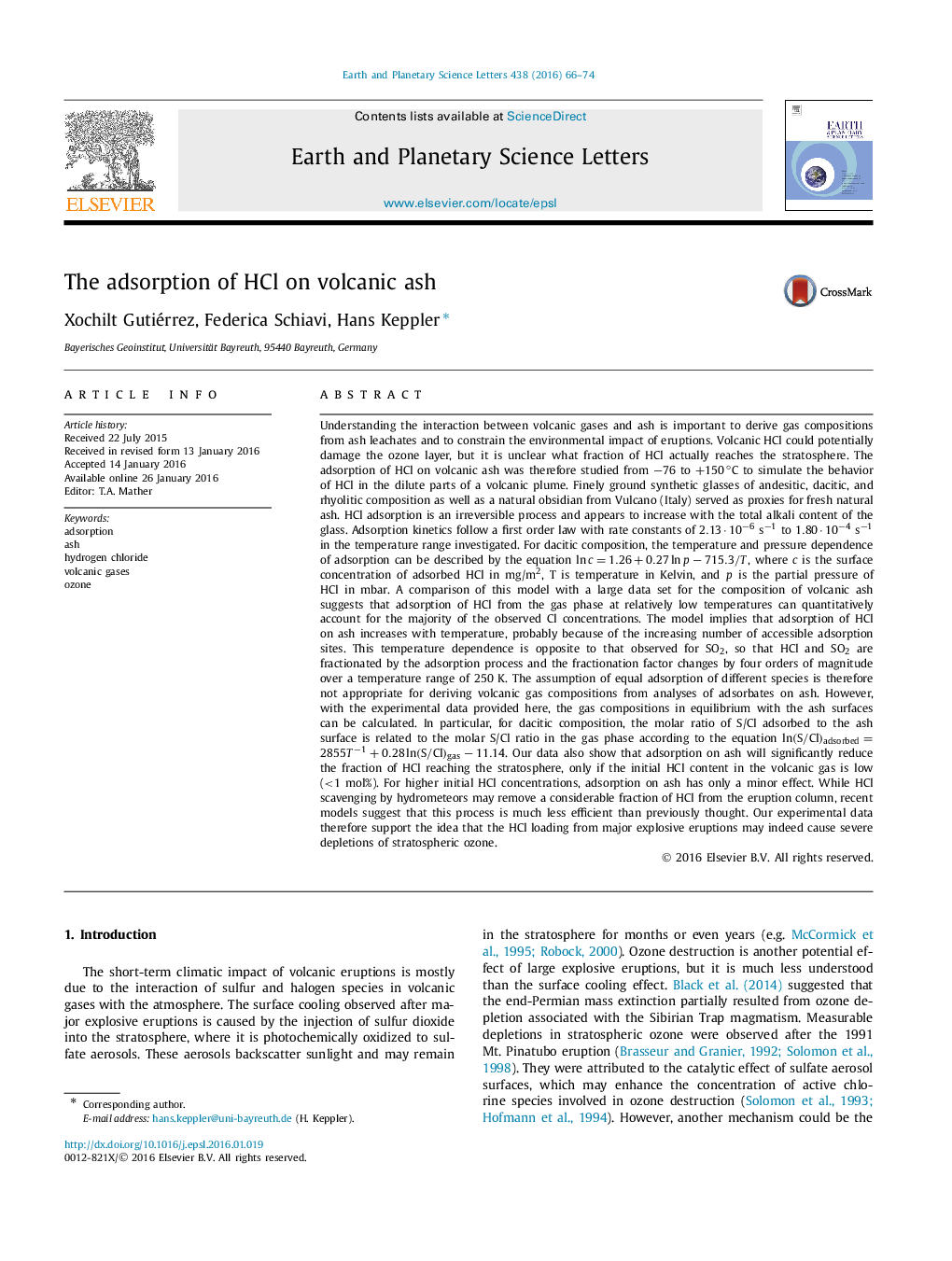| کد مقاله | کد نشریه | سال انتشار | مقاله انگلیسی | نسخه تمام متن |
|---|---|---|---|---|
| 4676935 | 1634718 | 2016 | 9 صفحه PDF | دانلود رایگان |

• HCl adsorption on volcanic ashes is irreversible.
• HCl adsorption on ashes occurs mostly in the cool, dilute part of the plume.
• HCl and SO2 are fractionated by adsorption on ashes and the fractionation factor changes by four orders of magnitude over 250 K.
• For eruptions with high initial HCl content in the gas, adsorption does not significantly reduce the stratospheric HCl loading.
Understanding the interaction between volcanic gases and ash is important to derive gas compositions from ash leachates and to constrain the environmental impact of eruptions. Volcanic HCl could potentially damage the ozone layer, but it is unclear what fraction of HCl actually reaches the stratosphere. The adsorption of HCl on volcanic ash was therefore studied from −76 to +150 °C to simulate the behavior of HCl in the dilute parts of a volcanic plume. Finely ground synthetic glasses of andesitic, dacitic, and rhyolitic composition as well as a natural obsidian from Vulcano (Italy) served as proxies for fresh natural ash. HCl adsorption is an irreversible process and appears to increase with the total alkali content of the glass. Adsorption kinetics follow a first order law with rate constants of 2.13⋅10−6 s−12.13⋅10−6 s−1 to 1.80⋅10−4 s−11.80⋅10−4 s−1 in the temperature range investigated. For dacitic composition, the temperature and pressure dependence of adsorption can be described by the equation lnc=1.26+0.27lnp−715.3/Tlnc=1.26+0.27lnp−715.3/T, where c is the surface concentration of adsorbed HCl in mg/m2, T is temperature in Kelvin, and p is the partial pressure of HCl in mbar. A comparison of this model with a large data set for the composition of volcanic ash suggests that adsorption of HCl from the gas phase at relatively low temperatures can quantitatively account for the majority of the observed Cl concentrations. The model implies that adsorption of HCl on ash increases with temperature, probably because of the increasing number of accessible adsorption sites. This temperature dependence is opposite to that observed for SO2, so that HCl and SO2 are fractionated by the adsorption process and the fractionation factor changes by four orders of magnitude over a temperature range of 250 K. The assumption of equal adsorption of different species is therefore not appropriate for deriving volcanic gas compositions from analyses of adsorbates on ash. However, with the experimental data provided here, the gas compositions in equilibrium with the ash surfaces can be calculated. In particular, for dacitic composition, the molar ratio of S/Cl adsorbed to the ash surface is related to the molar S/Cl ratio in the gas phase according to the equation ln(S/Cl)adsorbed=2855T−1+0.28ln(S/Cl)gas−11.14ln(S/Cl)adsorbed=2855T−1+0.28ln(S/Cl)gas−11.14. Our data also show that adsorption on ash will significantly reduce the fraction of HCl reaching the stratosphere, only if the initial HCl content in the volcanic gas is low (<1 mol%). For higher initial HCl concentrations, adsorption on ash has only a minor effect. While HCl scavenging by hydrometeors may remove a considerable fraction of HCl from the eruption column, recent models suggest that this process is much less efficient than previously thought. Our experimental data therefore support the idea that the HCl loading from major explosive eruptions may indeed cause severe depletions of stratospheric ozone.
Journal: Earth and Planetary Science Letters - Volume 438, 15 March 2016, Pages 66–74